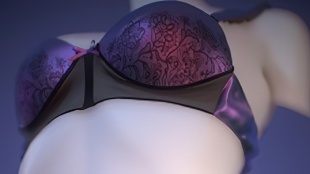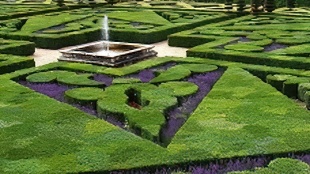您需要 登录 才可以下载或查看,没有账号?注册

x
 [翻译] : 本帖最后由 秋令6689 于 2022-6-14 19:53 编辑 在他对项目的分解中,详细讨论了如何在Substance Designer、SpeedTree和Megascans中制作逼真的植被。项目背景该项目源于我学习游戏美术时的任务,老师要求我们创作一个室内外场景。受到某款游戏的启发,我选择了以游戏中沼泽环境为基础的设计。 [翻译] : 本帖最后由 秋令6689 于 2022-6-14 19:53 编辑 在他对项目的分解中,详细讨论了如何在Substance Designer、SpeedTree和Megascans中制作逼真的植被。项目背景该项目源于我学习游戏美术时的任务,老师要求我们创作一个室内外场景。受到某款游戏的启发,我选择了以游戏中沼泽环境为基础的设计。
项目目标我想要通过这个项目专注于树叶的表现,尝试发挥其全部潜力。在制作过程中,我认识到要让植被看起来自然并非易事,因此我独立制作了一个“植被场景”,以便更好地开发和理解树叶的布局,确保在主环境中保持一致性。
灵感来源《Hunt Showdown》这款游戏的植被设计给我提供了很多灵感,它的植被丰富且服务于游戏玩法。我试图在我的项目中重现这种易读性和植被形式语言。
纹理设置为了达到逼真的植被效果,你需要根据时间和是否自己制作材料来选择纹理获取方式。可以直接使用扫描的植被,如从网站获取,这提供高质量纹理,但可能不符合个人需求。另外,也可以使用SpeedTree生成纹理,或者利用Megascans的数据,虽然它可能需要更多时间设置。
在Substance Designer中,控制植被的关键在于着色器的正确使用。混合扫描和程序纹理时,纹理间的差异是一个挑战,但通过精心设计的主材质可以弥补。
主材质示例这里展示了一种树叶的主材质,通过调整参数如粗糙度、颜色、SSS或法线,可以改变着色器的不同通道。
在Megascans中,我从多个图集找到符合需求的植物,为了节省空间,将它们合并到一个图集中,优化工作流程。
接下来,我创建了一些材质,并导入了Megascans的地图。注意要调整镜面反射的粗糙度设置,避免视口渲染问题,确保地图导出正确。颜色应设置为纯白,以免产生扭曲。
在网格编辑阶段,我调整了网格设置,确保只导出纹理。然后在视口中预览,设置了4k分辨率和渲染方块,便于观察。
通过切换到不透明度模式,更好地查看地图集,并在视口中调整位置。注意不要让地图集太靠近纹理边缘或相互重叠。
完成新地图集后,导入回Substance Designer并整合到一个简单的生成器中,进行模糊处理、SSS或粗糙度调整,以及为UE4准备地图。
Substance Designer的最新更新使我能够使用“Scatter”节点,自动识别并分散地图,如树干上的苔藓贴图。
举例来说,通过使用Megascan资产和Substance Designer的Scatter节点,我可以快速制作出多种地图集变化。
苔藓着色器的实现为了实现苔藓效果,我使用了顶点绘画保持精确控制,通过HeightLerp节点和MatLayerBlendStandar节点混合材料,调整不同颜色通道来添加苔藓、粗糙度和泥土效果。
我还添加了一个自定义RGB蒙版,以增加现实感,确保蒙版应用得更自然。
最后,我利用UE4的"Fuzzy Shading"节点制作了边缘的苔藓效果,通过调整菲涅尔值和纹理对比度,完成了着色器参数设置。
SpeedTree的应用几个月前发现SpeedTree的强大之处,它可以用来制作树木,也可以制作地图集、复用现有数据,创建各种小型植物。我所有的植物都来源于SpeedTree的创作。
本帖最后由 秋令6689 于 2022-6-14 19:53 编辑
-授权微元素发布-
https://ducrocq_hugo.artstation.com/

Ducrocq Hugo did a breakdown of his Swamp Vegetation project and covered the production of realistic vegetation in Substance Designer, SpeedTree, and Megascans.
About Swamp Vegetation ProjectThis project came to be as a part of my Game Art studies. Our teacher asked us to create a whole indoors/outdoors scene. Because I had recently played Hunt Showdown and it inspired me a whole lot, I settled on a swamp environment based on what I saw in that game. My goal with this project was to make it an exercise in foliage, trying to exploit its full potential. During the project, I realized how complex it is to make vegetation look right. This is why I made this small “vegetation scene” apart from my main environment in order to better develop my foliage, understand the way I would need to place it, and how I would keep it coherent and readable in my main scene. Ducrocq Hugo对他的沼泽植被项目进行了分解,并在Substance Designer,SpeedTree和Megascans中涵盖了逼真的植被的制作。
关于沼泽植被项目这个项目后来成为我游戏艺术研究的一部分。我们的老师要求我们创建一个完整的室内/室外场景。因为我最近玩过 《狩猎对决》,它给了我很大的启发,所以我根据我在那个游戏中看到的东西,选择了一个沼泽环境。 我这个项目的目标是让它成为树叶的练习,试图充分发挥其潜力。在项目期间,我意识到使植被看起来正确是多么复杂。这就是为什么我除了主环境之外,还制作了这个小的“植被场景”,以便更好地开发我的树叶,了解我需要放置它的方式,以及如何在主场景中保持它的连贯性和可读性。

InspirationHunt Showdown is a PVP/PVE Co-op Game, in which vegetation is ubiquitous. The game takes place in an ominous-looking swamp where foliage can be seen everywhere. The Hunt Team has managed to create vegetation that is coherent, legible, natural, and that above all serves the gameplay. This is what I wanted to convey in my project: legibility and the language of form through vegetation. 灵感 狩猎对决是一款PVP / PVE合作游戏,其中植被无处不在。游戏发生在一个看起来不祥的沼泽中,到处都是树叶。 狩猎团队已经设法创造了连贯,清晰,自然的植被,最重要的是为游戏玩法服务。这就是我想在我的项目中传达的:易读性和通过植被的形式语言。
Setting Up TexturesTo achieve realistic vegetation you have to choose how you will obtain your textures, depending on your time, and whether you wish to make your own materials or not. You may simply use vegetation scans such as those you can find on Megascans; this gives you access to high-quality textures and does save a lot of time, but may not be suitable for your needs. You can also use Photoshop (in a rather straightforward way) to create your own texture, or you may choose to use Substance Designer, which offers you the possibility to iterate quickly but takes a lot of time to set up. I chose to mix techniques: I wished to learn both how to make vegetation with Substance Designer and how to integrate vegetation from Megascans correctly. 设置纹理 要获得逼真的植被,您必须选择如何获得纹理,具体取决于您的时间以及您是否希望制作自己的材料。您可以简单地使用植被扫描,例如您可以在 Megascans上找到的那些;这使您可以访问高质量的纹理,并且确实节省了大量时间,但可能不适合您的需求。您还可以使用 Photoshop(以相当直接的方式)创建自己的纹理,或者您可以选择使用 Substance Designer,它为您提供了快速迭代的可能性,但需要花费大量时间来设置。 To me, one of the most important aspects of vegetation, and how one keeps control over it inside UE4, is the correct use of Shaders. Indeed, the most problematic thing when you mix scans and procedural textures is the gap between the different textures. Thankfully, this can be largely compensated with a proper Master Material. 我选择了混合技术:我希望学习如何使用Substance Designer制作植被,以及如何正确集成Megascans中的植被。 对我来说,植被最重要的方面之一,以及如何在 UE4中控制它,就是正确使用着色器。实际上,当您混合扫描和程序纹理时,最成问题的是不同纹理之间的间隙。值得庆幸的是,这在很大程度上可以通过适当的主材料来补偿。 Here is the Master Material for the foliage. There are several parameters that allow adjusting the different passes of the shader, such as its roughness, color, SSS or normal. 这是树叶的主材质。有几个参数允许调整着色器的不同通道,例如其粗糙度、颜色、SSS 或法线。 The shader is not very complex in itself. I use simple scalar parameters and multiply colors to adjust everything. Whatever engine you are choosing to use, I advise you to switch between Lit and Unlit mode in the viewport, and even go further by checking the Roughness or the Normal. This will give you several perspectives on what you are doing and is the best way to achieve good results. Visualization allows you to check that everything is uniform and that nothing is too contrasted. 着色器本身并不是很复杂。我使用简单的标量参数和乘以颜色来调整一切。 无论您选择使用哪种引擎,我都建议您在视口中在“点亮”和“不亮”模式之间切换,甚至通过检查“粗糙度”或“法线”来进一步。这将使您对自己正在做的事情有几种看法,并且是取得良好结果的最佳方式。 可视化允许您检查所有内容是否统一,并且没有太对比。 Looking at Megascans, I found plants that suited my needs on many different atlases. To save a lot of texture space, I imported these in SpeedTree and recomposed them into a single atlas. This is a simple technique that allows me to better optimize my workflow and my scene. 通过Megascans,我在许多不同的地图集上找到了适合我需求的植物。为了节省大量的纹理空间,我在 SpeedTree中导入了它们,并将它们重新组合成一个图集。这是一种简单的技术,使我能够更好地优化我的工作流程和场景。
I then created some materials and imported the maps from Megascans. Note that I put the desired roughness settings on my specular, disregarding the viewport rendering of SpeedTree. This is so that the maps are exported correctly. Be careful to set all colors white, otherwise, the result will be slightly distorted. 然后,我创建了一些材质,并从Megascans导入了地图。请注意,我将所需的粗糙度设置放在镜面反射上,而忽略了 SpeedTree 的视口渲染。这样可以正确导出地图。小心将所有颜色设置为白色,否则,结果会略微失真。
I then go to the meshes section and edit a new mesh: here the mesh’s polycount doesn’t matter as you will only export textures.
然后,我转到网格部分并编辑新网格:在这里,网格的多边形计数无关紧要,因为您只会导出纹理。
Note: for the branch, I set the skin to "spine only" so that the branch is not visible. For the trunk, you can simply press H to hide the node.
注意:对于树枝,我将皮肤设置为“仅脊柱”,以便树枝不可见。对于主干,您只需按 H 即可隐藏节点。
Then, I set my viewport to the top view to capture my new atlases.
然后,我将视口设置为顶视图以捕获我的新地图集。
In the viewport parameters, I set the resolution to 4k and displayed the rendering square. 在视口参数中,我将分辨率设置为4k并显示渲染方块。
Then I went to the direct settings of the viewport and switched to “opacity mode” in order to have a better view of my atlases. I simpled placed my atlases by selecting my branch and pressing W to move it in the viewport. Caution! Do not paste the atlases too close to the edges of the textures or too close to each other! 然后,我转到视口的直接设置并切换到“不透明度模式”,以便更好地查看我的地图集。我通过选择我的分支并按W在视口中移动它来简单地放置我的地图集。 谨慎!不要将图集粘贴得太靠近纹理的边缘或彼此太近!
All I had to do now is to create my new atlas. I went to "File" (F10) where I could set the maps that would be exported and their resolutions. I made sure that they were in 4k resolution, and that the maps have no color other than pure white (set as “multiply”), otherwise, it distorts the Megascans maps and rework may be necessary.
我现在要做的就是创建我的新地图集。我转到“文件”(F10),在那里我可以设置要导出的地图及其分辨率。我确保它们处于4k分辨率,并且地图除了纯白色(设置为“乘法”)之外没有其他颜色,否则,它会扭曲Megascans地图,可能需要返工。
Once the atlas is done, I reimported it in Substance Designer and plugged it into a simple generator that I made. It allowed me to blur the padding around the plants, adjust the SSS or roughness, and pack the maps for UE4. Also, thanks to Substance Designer’s last update, I could use the “Scatter” node which scatters atlases that it recognizes automatically. For example, the ground foliage or the lichen decals on the trunk are made using Megascan atlases that I scattered in Substance Designer thanks to this node. This allowed me to obtain several variations of the same atlas very quickly. 地图集完成后,我在 Substance Designer 中重新导入它,并将其插入到我制作的简单生成器中。它允许我模糊植物周围的填充,调整SSS或粗糙度,并为UE4打包地图。 此外,由于Substance Designer的上次更新,我可以使用“Scatter”节点,该节点可以分散它自动识别的地图集。例如,树干上的地面树叶或地衣贴花是使用Megascan图集制作的,由于这个节点,我将其分散在Substance Designer中。这使我能够非常快速地获得同一地图集的几种变体。
Examples of variations made quickly with Megascan assets and the Scatter node from Substance Designer:
使用Megascan资源和Substance Designer中的Scatter节点快速进行的变化示例:
If you are interested in this, I strongly advise you to go and see the work of Jobye-Kyle Karmaker and particularly his conference on the modular approach to vegetation in video games. He shares his experience and advice which have been very valuable to me! 如果你对此感兴趣,我强烈建议你去看看 Jobye-Kyle Karmaker的工作,特别是他关于视频游戏中植被的模块化方法的会议。他分享了他的经验和建议,这对我来说非常有价值!
Moss ShaderTo achieve this moss shader, I knew I wanted to use vertex painting in order to always keep precise control over it, rather than create moss that would only go on top of objects. The latter would not have been suitable for this project. Here is the moss shader. It may not be optimized for the usage in video games at the moment; I wanted to understand how to use a custom shader and make the most out of it for a small scene like this one.
苔藓着色器为了实现这种苔藓着色器,我知道我想使用顶点绘画,以便始终保持对它的精确控制,而不是创建只会在物体上覆盖的苔藓。后者不适合这个项目。 这是苔藓着色器。目前,它可能不会针对视频游戏中的使用进行优化;我想了解如何使用自定义着色器,并在像这样的小场景中充分利用它。
In my moss shader, I used the "HeightLerp" node which allows creating an alpha according to the height of a texture. I then combined it with the "MatLayerBlendStandar" node which allows blending materials according to a given alpha. 在我的苔藓着色器中,我使用了“HeightLerp”节点,该节点允许根据纹理的高度创建alpha。然后,我将其与“MatLayerBlendStandar”节点相结合,该节点允许根据给定的α混合材料。
I won't detail the whole shader here, because several points are repeated, but the main things to know are that I have a base material and secondary materials: in the base material I input the alpha of the MSK texture and the heightmap in order to use it in my "Height Lerp" node, then I connected one of the vertex colors to the height lerp node. Then, I mixed the two materials.
我不会在这里详细介绍整个着色器,因为有几个点是重复的,但要知道的主要事情是我有一个基础材质和辅助材质:在基础材质中,我输入了MSK纹理的alpha和高度贴图,以便在我的“Height Lerp”节点中使用它,然后将其中一个顶点颜色连接到高度lerp节点。然后,我将两种材料混合在一起。
I repeated this operation 3 times so that I could add moss, change the roughness, and add mud (or other material ), all of this thanks to the 3 vertex color RGB channels. Then, to make sure the mask is applied more realistically, I added a custom RGB Mask from Substance Designer with a black and white mask in each layer, with 3 different masks: one for foam, one for roughness, and one for mud. I multiplied this mask with the alpha output of the "Height Lerp" node. 我重复了3次此操作,以便我可以添加苔藓,更改粗糙度并添加泥浆(或其他材料),所有这些都要归功于3个顶点颜色RGB通道。 然后,为了确保更逼真的应用蒙版,我添加了一个来自Substance Designer的自定义RGB蒙版,每层都有一个黑白蒙版,有3个不同的蒙版:一个用于泡沫,一个用于粗糙度,一个用于泥浆。我将此蒙版与“高度 Lerp”节点的 alpha 输出相乘。
Here is the difference between two blends, with and without a custom mask:
以下是两种混合之间的差异,带和不带自定义蒙版:
Finally, UE4 has a node called "Fuzzy Shading" which allowed me to create a particular fresnel and create a moss effect on the edges of the texture. I just plugged it into the albedo at the very end. I recommend this node to everyone who wants to make moss in UE4 because it is quite realistic and can be tweaked.
最后,UE4有一个名为“模糊阴影”的节点,它允许我创建一个特定的菲涅耳,并在纹理的边缘创建苔藓效果。我只是在最后将其插入反照率。我向所有想在UE4中制作苔藓的人推荐这个节点,因为它非常逼真,可以调整。
As for the other settings, there's nothing complicated: I went from a simple scalar parameter to a multiply parameter to adjust tiling and contrast. Here are the final shader parameters: 至于其他设置,没有什么复杂的:我从一个简单的标量参数变成了一个乘法参数来调整平铺和对比度。以下是最终的着色器参数:
SpeedTree PotentialI discovered SpeedTree a few months ago and immediately saw the potential power of this software in production. I advise you to check out SpeedTree's official youtube channel where several well-made tutorials are listed. With SpeedTree, you can create trees, of course, but also as I showed earlier, create atlases or recombine them, create small plants, shrubs, bushes, etc. All my plants have been created in SpeedTree: 速度树潜力几个月前,我发现了SpeedTree,并立即看到了该软件在生产中的潜在功能。我建议您查看 SpeedTree的官方YouTube频道,其中列出了几个制作精良的教程。 使用SpeedTree,您可以创建树木,当然,也可以像我之前展示的那样,创建地图集或重新组合它们,创建小植物,灌木,灌木丛等。我所有的植物都是在SpeedTree中创建的。 | 




 [翻译] : 本帖最后由 秋令6689 于 2022-6-14 19:53 编辑 在他对项目的分解中,详细讨论了如何在Substance Designer、SpeedTree和Megascans中制作逼真的植被。项目背景该项目源于我学习游戏美术时的任务,老师要求我们创作一个室内外场景。受到某款游戏的启发,我选择了以游戏中沼泽环境为基础的设计。
[翻译] : 本帖最后由 秋令6689 于 2022-6-14 19:53 编辑 在他对项目的分解中,详细讨论了如何在Substance Designer、SpeedTree和Megascans中制作逼真的植被。项目背景该项目源于我学习游戏美术时的任务,老师要求我们创作一个室内外场景。受到某款游戏的启发,我选择了以游戏中沼泽环境为基础的设计。

 评分
评分






